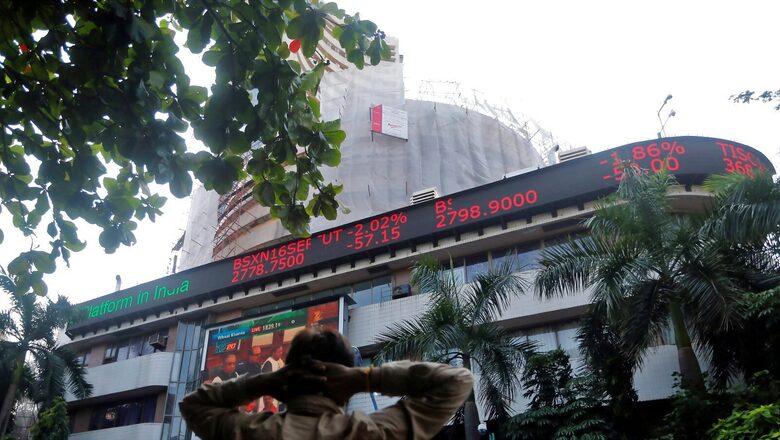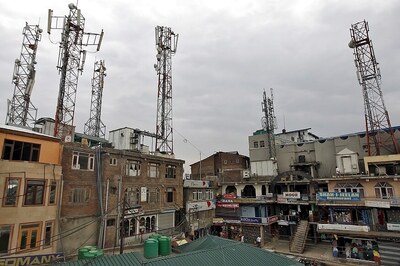
views
Bears attacked the market, especially in the last hour of trading. HDFC twins along with Infosys remained key laggards for the second consecutive day dragging the market sharply on Tuesday. Indian and global markets were hit hard today after Ukraine said a long-expected offensive push into the Donbas region in eastern Ukraine has started, with intensified assaults in the north and east of the country.
The benchmark BSE Sensex plunged 1,183 points from Tuesday’s high and settled 703 points down at 56,463 levels. The index had hit an intra-day low of 56,009 level. The NSE Nifty50, on the other hand, broke below the level of 17,000 and ended at 16,959, down 215 points. Both the indices slipped 1.2 per cent each.
HDFC twins along with Infosys remained key laggards for the second consecutive day dragging the market sharply. HDFC tanked 6.1 per cent to close at Rs 2,125 on BSE. HDFC Bank was down for the ninth straight session. As it fell 3.73 per cent to Rs 1,343.30. Meanwhile, Infosys dropped 3.55 per cent to Rs 1,563.95 and TCS had declined 1.53 per cent to Rs 3,474.30. These four stocks have contributed nearly 650 points to today’s Sensex fall.
Is It The Right Time To Buy The Dip?
The long-term structure of the Indian market is bullish, however, we are going through a lot of bumps in the short term like geopolitical tension, higher commodity prices, and rising interest rates, say market experts.
Santosh Meena, head of research, Swastika Investmart Ltd., said: “inflation is the biggest challenge and if the growth loses track, it could become the biggest sentiment dampener. Some economists are pointing toward global stagflation, a situation of low growth and high inflation, otherwise Indian market is going through a transformation to outperform.
“As I said, we are bullish on the Indian market for the next 3-5 years despite some global risks, therefore every correction should be taken as a buying opportunity, however, sector and stock selection will be the key in such kind of a market. We are very bullish on economic facing sectors like Infra, Capital goods, Real estate, and Banking,” Meena said.
Vikram Kasat, Head- Advisory and Western Region at Prabhudas Lilladher, said: “Of course yes. No one knows how much the market can fall or rise at any point in time. So if we are getting a chance even with a small dip then we should buy rather than wait for the market to fall more. What if the market doesn’t fall more ?”
Nifty Technical Outlook
Vikas Jain, senior research analyst at Reliance Securities, said: “NIFTY50 has witnessed 50 per cent corrective action of the entire up move from 16,000 to 18,000 levels, the large index heavyweights has pulled the indices lower over the past 8 trading sessions. NIFTY50 is trading near the 200-day average and we believe it provides a good opportunity as it will be more stock specific with respect to the full-year results for FY22. Concerns with respect to higher inflation and higher crude prices could continue for the next few weeks which would keep the markets consolidating at current levels after a 5 per cent fall. 17,000-17,200 is the broader monthly average which is being held for the last several months, on the higher side 17,800-18,000 would act as strong resistance.”
What Investors Should Look at While Buying?
Rahul Shah-Co-Head of Research at Equitymaster, said ” I see Indian companies creating new profit records 8-10 years from now. And hence, fear regarding the best quality companies doesn’t make sense. These are companies run by great management teams with a solid track record of growth and profitability. Even if they go down in the current volatile market, they will eventually recover and go on to create new highs.”
“However, investors should be wary of stocks in weak competitive positions and with high leverage. These are typically stocks that have had many loss-making years in the past and have debt well in excess of equity on their balance sheets. The biggest risk to investing comes from buying such poor-quality stocks during a bull market. Such stocks if they fall, may never recover or stay flat for many years. Therefore, the idea should be to get rid of such stocks and stay put in good quality companies,” Shah.
Read all the Latest Business News and Breaking News here
















Comments
0 comment